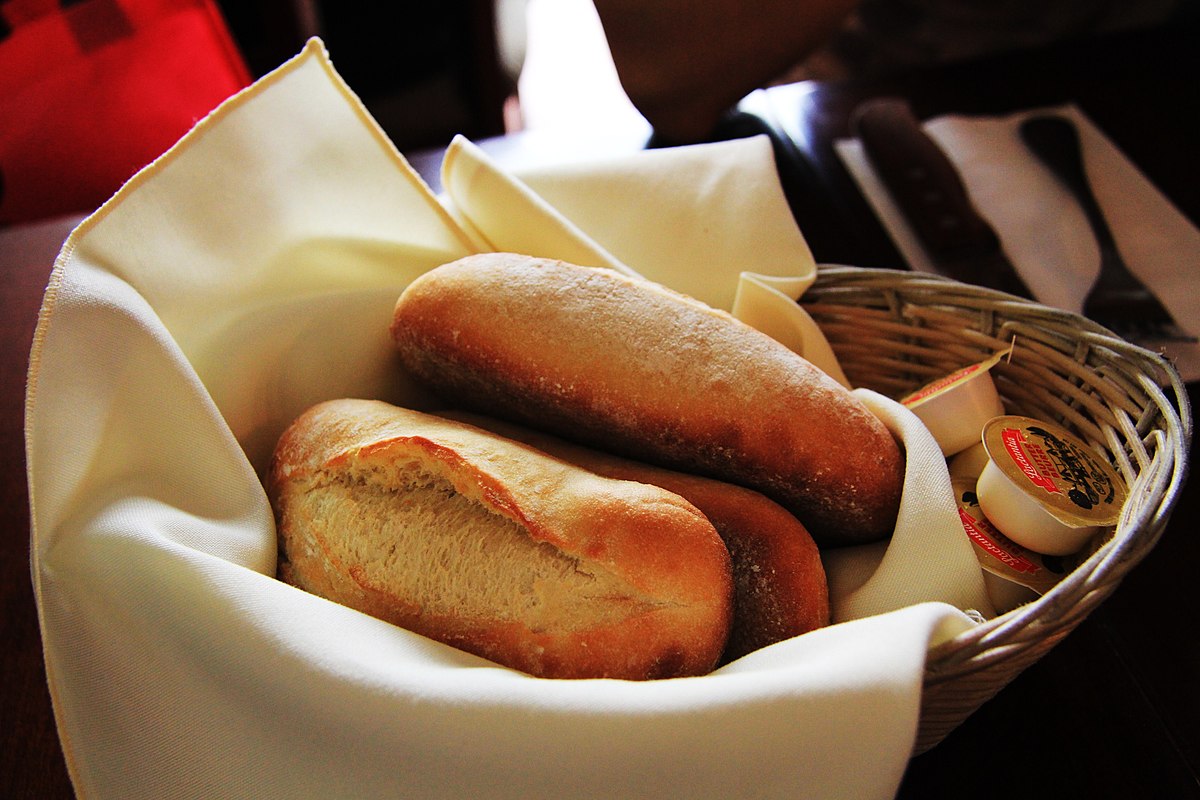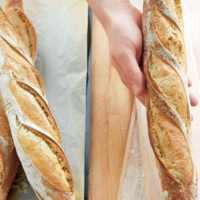
The Importance of Bread in French Dining
In French culture, bread is not merely a side dish; it’s an essential component of every meal. Understanding the proper etiquette surrounding bread consumption is always a plus for anyone dining in France or with French hosts. Here’s a guide to help you navigate the intricacies of bread etiquette in French dining…
The Centrality of Bread
Bread, particularly the baguette, is a staple in French cuisine. It’s present at nearly every meal, from breakfast to dinner, and is often used to accompany cheese, wipe plates clean, or simply enjoyed on its own.
When dining in France, you may be surprised to find that bread is typically placed directly on the tablecloth, not on a separate plate. This practice, while it may seem unhygienic to some, is a long-standing French tradition. If you’re at a more formal restaurant, you might be provided with a bread plate, but this is the exception rather than the rule.
Tearing, not cutting: When eating bread, tear off small, bite-sized pieces rather than cutting it with a knife. This is considered more polite and is the typical French way of consuming bread.
Accompaniments: While butter is common in some cultures, the French generally eat their bread plain or use it to accompany other foods. Don’t be surprised if butter isn’t provided with your bread.
Bread is typically available throughout the meal, but its use can vary:
- Starter: Use bread to accompany your appetiser.
- Main Course: Bread is often used to soak up sauces or juices from the main dish.
- Cheese Course: Bread is an essential companion to cheese, often used as a vehicle for softer cheeses.
Bread Etiquette Tips
- Don’t finish the bread basket during the starter. Save some for the main course and to clean your plate at the end of the meal.
- Use bread to wipe your plate clean at the end of the meal. This is considered a compliment to the chef and is perfectly acceptable in France.
- If sharing a bread basket, take your piece and place it on the table next to your plate. Don’t reach across the table to tear off pieces as you eat.
- Never spread cheese or pâté on a whole slice of bread. Instead, cut a small piece of cheese or pâté, place it on a torn piece of bread, and then eat it.
The Baguette
When purchasing a baguette, opt for “une tradition” for the best quality. This type of baguette is made with strict regulations and offers superior taste and texture.
Understanding these nuances of bread etiquette will help you dine like a true French person and fully appreciate the integral role of bread in French cuisine. Remember, in France, bread is not just food; it’s a cultural institution to be respected and enjoyed.
Simple French Baguette
Equipment
- Baker’s cloth
Ingredients
- * 500 g all-purpose flour plain
- * 325 g water at 20°C 68°F
- * 100 g Liquid Levain
- * 3 g fresh yeast crumbled
- * 10 g Guérande sea salt
Instructions
- Put the flour and water into a stand mixer fitted with a dough hook and mix for 4 minutes on low speed. Cover the mixer bowl with a damp cloth and rest for 1 hour, then add the levain, yeast and salt. Knead for 4 minutes on low speed, then for 7 minutes on high speed. The dough should be smooth and pull away from the sides of the bowl. Gather the dough into a ball, cover with a damp cloth and leave to rest for 1 hour 30 minutes at room temperature. The dough will have increased in volume by the end of the resting time.
- On a floured work counter, divide the dough into three equal pieces. Fold each piece over on itself, pulling gently to stretch into a longish log. Cover with a damp cloth and rest for 30 minutes at room temperature.
- Working with one piece of dough at a time, use the palm of your hand to flatten it gently. With the long side facing you, fold in a third towards the middle and press along the edge with your fingertips. Swivel the dough 180 degrees. Fold in the other long edge so that it overlaps in the centre and press with the heel of your hand. Fold one half on top of the other and seal the edges together with the heel of your hand.
- With lightly floured hands, roll the baguette out to 55 cm (21 inches) long, then pinch each end into a point. Repeat with the other 2 baguettes.
- Carefully lift the baguettes onto a lightly floured baker’s cloth, seams underneath. Separate them by making folds in the cloth. Cover with a damp cloth and prove (proof) for 1 hour 40 minutes at room temperature, by which time the baguettes will have increased in volume.
- Place a baking pan on the lowest rack of the oven and preheat the oven to 230°C (450°F). Gently place the baguettes, seam down, on a baking sheet lined with baking (parchment) paper. Dust with flour and make
- 4 evenly spaced oblique slashes along the length of each baguette. Once the oven is hot, pour 50 ml (31⁄2 tbsp/ 13⁄4 fl oz) water into the hot baking pan. Put the baguettes and pan of water into the oven and bake for 20 minutes.
- Remove the loaves from the oven, then cool on a wire rack.
Video
Share to: Facebook Twitter LinkedIn Email
More in Baguette




